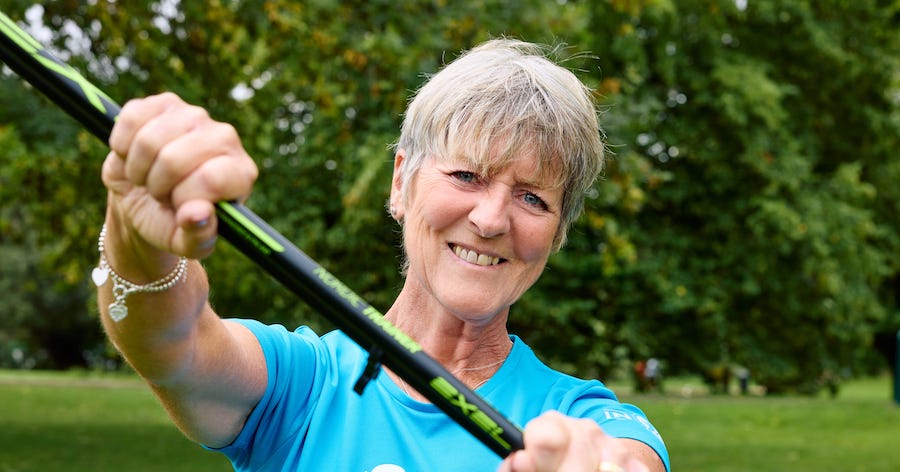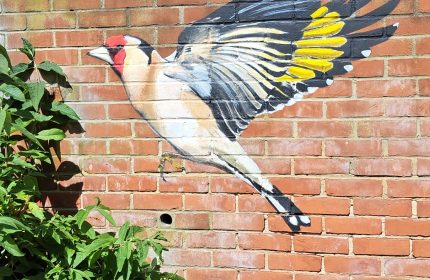How staying active is helping people manage Parkinson’s
From reduced symptoms to a mental boost, we hear more about the vital role keeping active plays for many living with the condition.
Every Wednesday, 65-year-old grandmother Sara Dove attends a samba drumming class. It’s an hour of “really, really good fun”, she says. It’s also helping her manage Parkinson’s.
“First of all, it’s a cardio workout, which is great. It’s also a mental workout, because you’re keeping your neural pathways open and making more neural pathways. And it helps with movement, we always do a bit of a dance at the end, and it’s good for hand-eye coordination,” says Dove, who was diagnosed three years ago and is a member of SParky Samba in Cardiff, a group set up for anyone affected by Parkinson’s.
“It’s also a great psychological boost. A real dollop of dopamine.”
Dove is one of around 153,000 people in the UK living with the progressive neurological condition. It means nerve cells that produce dopamine have stopped working, resulting in a wide range of symptoms relating to the brain and largely involving movement, which is why Parkinson’s is often associated with a tremor.
This month shines a light on the condition, with April being Parkinson’s Awareness Month and World Parkinson’s Day on April 11.
View this post on Instagram
In the past, it’s often been portrayed as an ‘older person’s’ illness – but numbers are growing, with two more people diagnosed every hour according to the charity Parkinson’s UK, including a significant amount of under-50s.
While there’s currently no cure, many living with the condition are determined to highlight that there are things that help you live well with it.
For Dove and many others, the difference keeping active makes to how they feel is all the evidence they need that it’s worthwhile. But there’s a growing body of research into this area too, which is why it’s now a recommended aspect of symptom management.
“At Parkinson’s UK, we know how important it is to be physically active,” says Tim Morton, the charity’s Physical Activity Programme Lead. “It’s as important as getting the right medication in helping to manage your symptoms. Just two-and-a-half hours a week can make a real difference to living well with the condition and can have a positive impact physically, mentally and socially.”

Sara Dove in her SParky Samba T-shirt
For former P.E. teacher and marathon runner Christine Stanley, 61, being active has always been a big part of her life. After being diagnosed with Parkinson’s six years ago she was encouraged to try Nordic walking (a full-body walking workout using poles – which can be ideal for people with Parkinson’s as it also helps with balance and gait) and has since qualified as an instructor, leading two weekly groups in the Nottingham area, including Parkinson’s Nordic walkers.
“It’s truly transformed my life and given me a real purpose,” says Stanley, who also still enjoys ballet and yoga, among other things. Long before Parkinson’s, she had previously been through cancer after being diagnosed with Hodgkin’s lymphoma aged 29.
“After that, I thought my motto for life was to keep as fit as I could,” she explains. “I feel exercise really can help mitigate symptoms and make you feel good.”
View this post on Instagram
There are over 40 symptoms officially associated with Parkinson’s (including muscle rigidity, slow movement, pain and sleep problems), and how the condition progresses varies from person to person. Many symptoms are also ‘invisible’.
“When you have Parkinson’s, people often don’t understand the quiet symptoms, the ones you can’t see – you can suffer from lack of confidence, you’re broken when you hear you’ve got it, you catastrophise. You can spiral downwards,” explains Stanley, who believes it’s a case of “use it or lose it” when it comes to staying active.
She appreciates taking those first steps can be much harder for people who’ve not been fit and active their whole lives, and especially if they’re not encouraged and supported after being diagnosed. Also, there will be days when motivation is low.
“Some of the participants that come to my Nordic walking, they don’t want to come some mornings, but they get themselves there, and they generally say to me they’re so glad they came because they feel so much better. They feel invigorated, their symptoms decrease, they’ve got a lot more to talk about. And because I’ve got it, I understand,” says Stanley.
“But they think I’m fearsome – I don’t let them off lightly, we do a proper class!”
For Dale Hancock, 63, being active was something he’d dipped in and out of when younger, but it drifted as life got busy with family and work and following two hip replacements and knee surgeries.
But after being diagnosed with Parkinson’s in his early-50s, he followed advice to take up something low-impact and starting using a rowing machine. This progressed to joining a local gig rowing club, which is popular along the Devon coast where he lives.

Dale Hancock (R) during a practice row with his gig pilot club off the coast of Clovelly
“I’d seen it before but I’d never thought I’d have a go at it,” Hancock says of the sport, where teams compete in traditional six-oar 32ft wooden Cornish pilot gig boats. “But one day my wife Althea said, ‘Go on, have a go’, so I went down. That was 10 years ago and I’ve been going ever since.
“I find it helps me with Parkinson’s because it’s quite repetitive and makes you concentrate. When I’m rowing, I’m not shaking. I don’t know if it’s because I’m enjoying it, or I’m concentrating on the rowing.”
It’s now a big part of his life (his team’s off to take part in the World Championships on the Isles of Scilly later this month), and Hancock has since also been inspired to reconnect with an old passion from his youth – motorcycle scrambling.
“I thought, well it’s now or never,” says Hancock, whose urge to give it another go was reignited after a friend restored their old classic bike. He bought a bike, started joining local races, and hasn’t looked back.
“It was quite scary at first, but I find the fact I’ve been doing rowing quite helpful, because it’s a lot of leg and arm strength, and that crossed over to a certain extent, and my balance is alright,” he says.
“I’m not going to win anything, but I like doing it, because I can do it. The way I see it is, I might not be able to do it next year, so I’m going to keep going for as long as I can.
“My wife’s really supportive, she comes along and helps me get changed and washes the bike off. And cooks the bacon baps and brews the tea up in the pits for everyone coming around. It’s a good social event as well.”
The social element is really important, as Dove and Stanley both also agree.
Dove recalls having “reservations” about joining SParky Samba initially, as it was the first time she’d joined any sort of group for the Parkinson’s community.
“But I’m so glad I took the first step,” says Dove. “It’s so fun – we laugh, we joke, it’s a safe space, you can have a little whinge about your symptoms, or you can have a laugh about something funny that might have happened.
“I would honestly say to anyone, just be bold, take that first step, you don’t know where it will lead.”
:: For more information about Parkinson’s, visit parkinsons.org.uk. The charity also has a ‘Being Active with Parkinson’s’ guide available in English and Welsh.
:: Christine Stanley is leading a Nordic Walking for Parkinson’s event at the University of Nottingham, Lakeside Arts centre, for World Parkinson’s Day on April 11 at 11am. To enquire, email [email protected]
The Press Association
Latest posts by The Press Association (see all)
- Unseen photo of William and Kate’s wedding released to mark 13 years of marriage - April 29, 2024
- The Tattooist Of Auschwitz author Heather Morris on why now is the perfect time for a TV adaptation - April 29, 2024
- Fried halloumi and chickpea rainbow salad - April 29, 2024
- William and Kate celebrate 13th wedding anniversary - April 29, 2024
- Dame Kelly Holmes: ‘Getting old is a privilege but ageing I don’t like’ - April 27, 2024





















